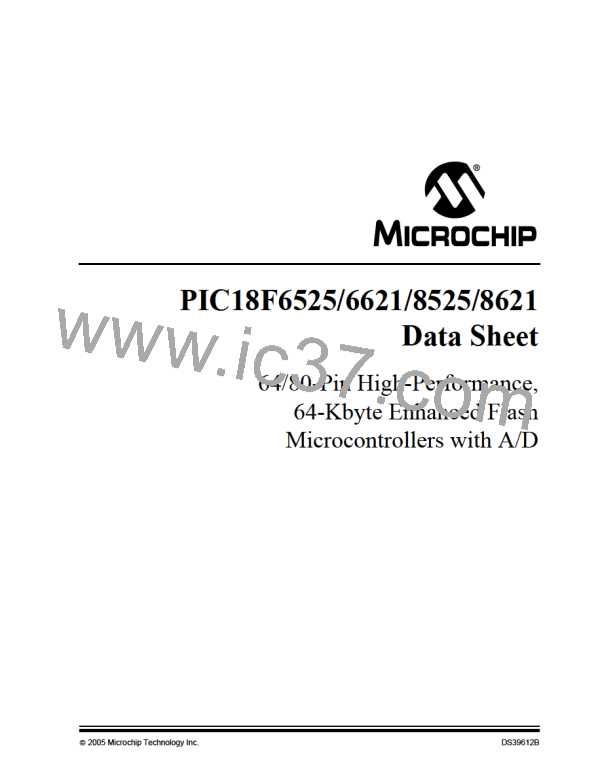PIC18F6525/6621/8525/8621
The clock polarity is selected by appropriately
programming the CKP bit (SSPCON1<4>). This then,
would give waveforms for SPI communication as
shown in Figure 18-3, Figure 18-5 and Figure 18-6,
where the MSB is transmitted first. In Master mode, the
SPI clock rate (bit rate) is user programmable to be one
of the following:
18.3.5
MASTER MODE
The master can initiate the data transfer at any time
because it controls the SCK. The master determines
when the slave (Processor 2, Figure 18-2) is to
broadcast data by the software protocol.
In Master mode, the data is transmitted/received as
soon as the SSPBUF register is written to. If the SPI is
only going to receive, the SDO output could be dis-
abled (programmed as an input). The SSPSR register
will continue to shift in the signal present on the SDI pin
at the programmed clock rate. As each byte is
received, it will be loaded into the SSPBUF register as
if a normal received byte (interrupts and status bits
appropriately set). This could be useful in receiver
applications as a “Line Activity Monitor” mode.
• FOSC/4 (or TCY)
• FOSC/16 (or 4 • TCY)
• FOSC/64 (or 16 • TCY)
• Timer2 output/2
This allows a maximum data rate (at 40 MHz) of
10.00 Mbps.
Figure 18-3 shows the waveforms for Master mode.
FIGURE 18-3:
SPI™ MODE WAVEFORM (MASTER MODE)
Write to
SSPBUF
SCK
(CKP = 0
CKE = 0)
SCK
(CKP = 1
CKE = 0)
4 Clock
Modes
SCK
(CKP = 0
CKE = 1)
SCK
(CKP = 1
CKE = 1)
bit 6
bit 6
bit 2
bit 2
bit 5
bit 5
bit 4
bit 4
bit 1
bit 1
bit 0
bit 0
SDO
(CKE = 0)
bit 7
bit 7
bit 3
bit 3
SDO
(CKE = 1)
SDI
(SMP = 0)
bit 0
bit 7
Input
Sample
(SMP = 0)
SDI
(SMP = 1)
bit 0
bit 7
Input
Sample
(SMP = 1)
SSPIF
Next Q4 Cycle
after Q2↓
SSPSR to
SSPBUF
DS39612B-page 178
2005 Microchip Technology Inc.

 MICROCHIP [ MICROCHIP ]
MICROCHIP [ MICROCHIP ]